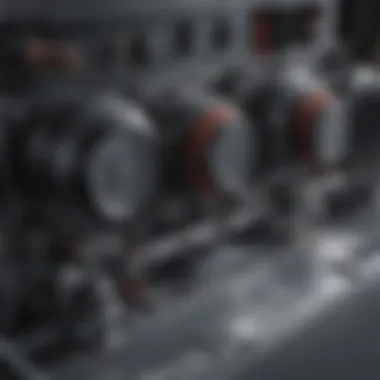Understanding Air Conditioning in Small Aircraft


Intro
The study of air conditioning systems in small aircraft is integral for understanding not just comfort, but also performance in aviation. In an environment where temperature and humidity can greatly affect the operation of an aircraft, the design and functionality of air conditioning systems become critical. This section introduces the emphasis on how these systems interact with various factors in aviation.
Effective air conditioning plays a pivotal role for both pilots and passengers, ensuring a tolerable cabin environment. Additionally, it contributes to the overall safety and efficiency of flight operations. Given the often harsh conditions of small aircraft, understanding the engineering behind these systems is essential.
Exploring small aircraft air conditioning reveals a variety of components and technology. This knowledge is particularly valuable for aviation students, engineers, and enthusiasts. With advancements in technology, air conditioning systems are continuously evolving, enhancing both comfort and operational capabilities.
The following sections will delve deeper into air conditioning system design, components, maintenance, and the challenges faced in extreme conditions. It will provide a holistic view, aimed to enlighten readers about this crucial aspect of aviation.
Preface to Air Conditioning in Aviation
Air conditioning plays a vital role in aviation, specifically within small aircraft. The climate inside an aircraft must be well-regulated to ensure comfort for both pilots and passengers. This control is not solely about comfort; it significantly impacts safety and operational efficiency. A proper air conditioning system maintains a stable temperature and optimal humidity levels, reducing fatigue and enhancing concentration during flight.
Importance of Climate Control
Climate control within small aircraft is essential for several reasons. First, it helps ensure that all occupants remain comfortable. Discomfort can lead to diminished focus, which is critical during flight operations. Pilots needs to operate in an environment that is free from extreme temperature fluctuations to make clear and informed decisions. Additionally, passengers must also experience adequate conditions, especially on longer flights, where extended exposure to uncomfortable temperatures can affect their overall flight satisfaction.
Furthermore, climate control contributes to the preservation of equipment and materials within the aircraft. Excessive humidity or temperature can cause corrosion, degrade electrical systems, and negatively affect the integrity of the aircraft's structure. Therefore, maintaining proper air conditioning is not only a matter of comfort but also a matter of ensuring long-term operational reliability.
Historical Overview
The development of air conditioning in aviation has evolved significantly since the early days of flight. Initially, small aircraft lacked sophisticated climate control systems, leading to challenging conditions for pilots and passengers. Early aviation was characterized by open cockpits and minimal protections against weather elements. The advent of enclosed cockpits in the 1930s marked a turning point. After World War II, there was increased interest in enhancing passenger comfort on commercial flights, which laid groundwork for advancements in air conditioning technology.
As aircraft designs continued to evolve, so did the approaches to climate control. The introduction of refrigerants and modern air conditioning systems allowed for more effective solutions. Today, small aircraft can utilize lightweight and compact systems to efficiently manage cabin temperatures and environments. This history underscores the importance of innovation and the necessity of adapting technology to meet changing needs in aviation.
Fundamentals of Air Conditioning Systems
In the context of small aircraft, understanding the fundamentals of air conditioning systems is essential. These systems are not merely an enhancement for comfort; they also play a crucial role in ensuring the safety and operational efficiency of the aircraft. The adverse effects of high temperatures and humidity on both the crew and passengers necessitate an effective climate control mechanism. A complete grasp of air conditioning fundamentals can lead to better design choices, maintenance practices, and operational efficiencies, which are pivotal for aviation professionals.
Basic Principles of Refrigeration
Refrigeration serves as the backbone of all air conditioning systems. Central to this process are the laws of thermodynamics, which dictate how heat is transferred. In simple terms, a refrigeration cycle works by absorbing heat from the aircraft's interior and expelling it outside. This is typically achieved through four primary stages: compression, condensation, expansion, and evaporation. Each stage performs a unique function, continually recycling the refrigerant to maintain a controlled climate inside the aircraft. Understanding these principles allows engineers to optimize air conditioning designs that can perform under the specific conditions found in aviation.
Components of Air Conditioning Systems
The configuration of an air conditioning system includes various critical components, each fulfilling an indispensable role.
Compressor
The compressor acts as the heart of the air conditioning system. Its primary task is to compress the refrigerant gas, raising both its pressure and temperature. The key characteristic of compressors used in aviation is their compact size and high efficiency. Models like the Sandwich Compressor stand out due to their ability to operate efficiently in confined spaces, which is often a necessity in small aircraft. However, one should be mindful of the noise and vibration levels associated with certain compressors, as these factors may affect passenger comfort.
Condenser
The condenser is integral to the heat exchange process. As the high-pressure refrigerant gas passes through the condenser, it dissipates heat to the outside environment, transforming into a liquid. A popular choice for small aircraft is the Air-Cooled Condenser, known for its reliability and ease of maintenance. This component often features lightweight materials, which are vital for weight-sensitive aircraft. However, it may struggle in extremely hot conditions, potentially reducing its efficiency.
Evaporator
The evaporator, positioned within the cabin, serves the purpose of cooling the air circulating inside. As the liquid refrigerant enters the evaporator and absorbs heat from the cabin air, it vaporizes, leading to a drop in temperature. The essential feature of evaporators in aircraft is their ability to provide a swift cooling effect. They often utilize finned tubes to maximize surface area, enhancing air contact. One drawback is their reliance on airflow; if not properly maintained, dust and debris may clog the fins, reducing efficiency and performance.
Expansion Valve
The expansion valve is responsible for regulating the flow of refrigerant into the evaporator. It lowers the pressure of the refrigerant, allowing it to expand and cool before entering the evaporator. The Thermostatic Expansion Valve is widely utilized for its precision in controlling refrigerant flow. This characteristic makes it a favorable component for enhancing overall system efficiency. However, a drawback could be its sensitivity to temperature changes, which may impact performance if not adequately monitored.
Understanding the components of an air conditioning system in small aircraft allows for improved design and maintenance practices, making them safer and more efficient.
The knowledge of these components and their functions is paramount for engineers and technicians working in the aviation industry. It not only enhances the decision-making process for system design but also ensures effective maintenance protocols, leading to improved aircraft performance.


Types of Air Conditioning Systems in Small Aircraft
Understanding the various types of air conditioning systems in small aircraft is crucial for optimizing performance and ensuring comfort during flight. Each system has its own design, operational principles, and suitability based on aircraft specifications and intended use. Selecting the appropriate type can contribute significantly to energy efficiency and overall passenger experience. This section will explore three primary types: packaged units, split systems, and ventilation systems. Each type serves specific needs and is essential for different aircraft configurations.
Packaged Units
Packaged units are self-contained systems, meaning that they contain all necessary components within a single unit. This design simplifies installation and maintenance, making them popular in smaller aircraft where space is limited. Their compact nature reduces the amount of ductwork required, which further alleviates weight concerns—an essential factor in aviation.
In terms of operational efficiency, packaged units often deliver consistent cooling and heating performance. They can use either ambient air or recirculated air, balancing comfort and energy use. One notable advantage is the lower initial cost compared to other systems, which can be vital for budget-conscious operators. However, one must consider the limitations in terms of customizability and capacity—these units may not adequately meet the demands of larger or more complex aircraft environments.
Split Systems
Split systems consist of two main components: an indoor unit and an outdoor unit, connected by refrigerant lines. This design allows for greater flexibility in installation. Because the components can be placed separately, this can help optimize cabin space and design. Aircraft with these systems can benefit from enhanced cooling capacity and better efficiency, as the outdoor unit can be larger without affecting cabin dimensions significantly.
One critical aspect of split systems is their ability to provide targeted climate control for different cabin zones, which improves overall comfort. In regions with variable climates, this adaptability is particularly advantageous. However, with these systems, maintenance can be slightly more complex due to the interconnected nature of components.
Ventilation Systems
Ventilation systems play a crucial role in maintaining air quality in the aircraft. Unlike cooling systems that primarily focus on temperature, ventilation systems ensure a continuous flow of fresh air. This is especially important in small aircraft, where space can lead to stale conditions. These systems often work in conjunction with air-conditioning units, drawing in outside air to refresh the cabin atmosphere while managing humidity levels effectively.
Ventilation systems are essential during ascent and descent, when the cabin pressure changes rapidly. Their ability to adapt to altitude variations helps in mitigating the potential discomfort associated with flying. Moreover, these systems are designed to provide safety by reducing the concentration of contaminants, which is especially relevant amid public health concerns.
In summary, understanding the specific types of air conditioning systems in small aircraft—packaged units, split systems, and ventilation systems—can greatly enhance decision-making regarding aircraft design and operation. Each has unique benefits and considerations, which can ultimately affect passenger comfort, maintenance protocols, and overall efficiency.
Design Considerations for Aircraft Air Conditioning
When designing air conditioning systems for small aircraft, it is crucial to assess several factors that can influence overall efficiency and functionality. This section focuses on three main aspects. They are weight and space constraints, integration with aircraft systems, and compliance with efficiency standards and regulations. Each of these elements has vital implications for the design process.
Weight and Space Constraints
In aviation, every component contributes to the overall weight of the aircraft. The air conditioning system is no exception. Weight savings can directly impact fuel efficiency and payload capacity. Therefore, it is important to choose lightweight materials without sacrificing durability and performance. For example, composite materials are often preferred over traditional metals because of their lower weight characteristics.
Space is another critical factor. Small aircraft usually have limited room for additional systems. Designers must carefully plan the layout of air conditioning components to maximize efficiency and minimize intrusion into the cabin area. Compact design solutions, such as integrated units that combine functions, help to conserve space without compromising comfort.
Integration with Aircraft Systems
Air conditioning systems in small aircraft should not operate independently. Instead, they should function seamlessly with other aircraft systems. Effective integration allows for better management of resources, such as electrical power and airflow.
For instance, the air conditioning system needs to synchronize with the aircraft’s environmental control systems to maintain optimal cabin conditions. This not only enhances passenger comfort but also ensures that the overall system operates efficiently. Designers must consider how components like sensors, controls, and ductwork interact with existing systems during the integration process.
Efficiency Standards and Regulations
Compliance with efficiency standards and regulations is paramount when designing air conditioning systems. Various aviation authorities impose strict guidelines to ensure safety and environmental protection. Understanding these regulations is essential to avoid costly modifications after installation.
It’s necessary to evaluate energy consumption rates and refrigeration cycle efficiency. Systems that do not meet or exceed these standards may lead to penalties or issues during safety inspections. Therefore, adhering to regulatory frameworks can enhance overall system reliability and longevity.
"Adhering to efficiency standards ensures safety and maintains operational integrity."
Operational Parameters and Efficiency
Understanding the operational parameters and efficiency of air conditioning systems in small aircraft is integral to ensuring optimal performance and comfort. These systems have complex interactions that depend on environmental conditions, aircraft design, and operational demands. Maximizing efficiency in this context not only enhances passenger comfort but also impacts the overall flight experience, including fuel consumption and aircraft handling.
Optimal Performance Conditions
The concept of optimal performance conditions refers to the specific environmental and operational factors that allow air conditioning systems to function at their best. Several key elements contribute to these conditions:
- Ambient Temperature: The outside temperature directly influences the workload on the air conditioning unit. Higher outside temperatures can increase energy consumption.
- Humidity Levels: High humidity can lead to reduced effectiveness, as the system must work harder to dehumidify the cabin air.
- Altitude: As aircraft ascend, external pressure and temperature drop. The air conditioning system must adapt to these changes to maintain comfort.
- Aircraft Design: The layout and materials used in the aircraft can impact how efficiently air is circulated and conditioned.
Ensuring that the air conditioning system is fine-tuned to these operational conditions can yield significant improvements in both comfort and system reliability. Pilots and technicians must regularly monitor performance metrics to maintain these optimal conditions.


Energy Consumption and Performance Metrics
Energy consumption is a critical factor in assessing the efficiency of an aircraft's air conditioning system. This involves understanding how much energy is being utilized for conditioning cabin air relative to the system's capacity to maintain comfortable temperatures.
- Power Usage: The total wattage consumed by the air conditioning unit during operation is a primary metric. Lower power usage indicates higher efficiency.
- Cooling Capacity: This refers to the ability of the system to remove heat from the cabin. It is typically measured in British Thermal Units (BTU) or watts.
- Coefficient of Performance (COP): This metric evaluates the performance efficiency of the system by comparing the amount of cooling provided to the energy consumed. A higher COP represents a more efficient system.
Investing in advanced monitoring systems can aid in tracking these performance metrics. Regular assessments allow technicians to identify maintenance needs and ensure the system operates within its optimal parameters.
Regular monitoring of air conditioning systems in small aircraft can lead to improved efficiency, reduced operational costs, and enhanced passenger comfort.
In summary, understanding and managing the operational parameters and efficiency of air conditioning systems is vital for the overall performance of small aircraft. By focusing on optimal performance conditions and energy consumption metrics, aviation professionals can ensure systems run efficiently, leading to significant benefits in operational success and passenger satisfaction.
Impact of Air Conditioning on Aircraft Performance
The role of air conditioning systems in small aircraft extends beyond comfort for passengers and crew. It significantly influences overall aircraft performance. The relationship between air conditioning and performance encompasses aspects such as weight and balance and fuel efficiency.
Effects on Weight and Balance
Air conditioning systems add weight to small aircraft, which is a crucial consideration for several reasons. Each component, from the compressor to the ductwork, contributes to the overall mass of the aircraft. This increase in weight can affect the aircraft's structural integrity and handling.
- Weight Distribution: Proper weight distribution is essential for maintaining balance during flight. An improperly balanced aircraft can lead to difficult handling characteristics. The installation of air conditioning must consider how additional weight will be distributed throughout the aircraft.
- Regulatory Compliance: Aircraft must meet specific weight limits governed by aviation authorities. Exceeding these limits could prevent legal operation. Therefore, it is necessary to weigh the benefits of an air conditioning system against the impact on overall weight.
- Performance Limitations: Heavier aircraft may require more power to maintain optimal flight conditions, which can influence climb rates and maneuverability.
Influence on Fuel Efficiency
The impact of air conditioning on fuel efficiency is multifaceted. While air conditioning enhances comfort, it also consumes energy, which translates to fuel usage during flight.
- Energy Demand: The amount of power required by the air conditioning system can draw resources away from the aircraft’s propulsion system. This demand can lead to reduced fuel efficiency, particularly during critical phases of flight such as takeoff and climb.
- Operational Planning: Pilots and flight planners must consider the energy demands of air conditioning systems when calculating fuel loads and flight times. Understanding these factors can lead to more efficient route planning and resource allocation.
- Impact on Range: Increased fuel consumption due to air conditioning can decrease the overall range of the aircraft. Pilots should account for these variables when planning long-haul flights, ensuring that fuel reserves meet operational needs.
Proper management of air conditioning systems is essential not just for comfort, but also for optimizing aircraft performance and ensuring safety in flight operations.
In summary, air conditioning systems are an integral part of small aircraft design. Their impact on weight, balance, and fuel efficiency should be carefully analyzed to ensure that they complement the overall performance framework of the aircraft.
Challenges in Small Aircraft Air Conditioning
Air conditioning systems in small aircraft face several unique challenges that can affect performance, maintenance, and overall reliability. As these systems are tasked with providing comfort under varying atmospheric conditions, understanding these challenges is crucial for ensuring effective operation and longevity of the equipment.
Many factors contribute to the complexity of air conditioning in small aircraft, including size, weight limitations, and extreme environmental conditions. As passenger expectations for comfort grow, aircraft manufacturers must balance these demands against the technological and mechanical constraints specific to smaller aircraft. The efficiency of air conditioning systems can directly impact the aircraft’s performance, making it important to address the relevant challenges.
Extreme Temperature and Humidity Conditions
Air conditioning systems in small aircraft must operate effectively in a wide range of temperatures and humidity levels. This variability can greatly influence the performance of these systems. During hot climate flights, the system's cooling capabilities are put to the test, as it must counteract the external heat and maintain comfortable interior conditions.
Conversely, flying in high humidity can introduce additional strain. The presence of moisture in the air can lead to condensation, which may cause complications in the system. These extremes can sometimes exceed the specifications for which the air conditioning system was designed. Operators should be conscious of these factors when planning flight routes, as prolonged exposure to outside conditions can affect the integrity and functionality of air conditioning systems.
Some considerations include:
- Material Selection: Components must be resistant to corrosion, which is particularly important in humid conditions.
- System Design: Systems must be robust enough to handle sudden temperature changes effectively.
- Regular Monitoring: Continuous assessment of system performance in varied conditions can help prevent failures.
Maintenance and Repair Issues
Maintaining the air conditioning systems in small aircraft is paramount for operational safety and efficiency. Regular maintenance not only ensures peak performance but also addresses potential repair issues before they escalate. Given the confines of small aircraft, accessing and servicing the air conditioning units can present challenges.
Typical maintenance practices involve routine inspections of key components such as the compressor, condenser, and evaporator. Operators should be aware that failures in any part of the air conditioning unit can lead to a complete system malfunction, causing discomfort to passengers and potentially affecting safety.
Common repair issues include:
- Refrigerant Leaks: A common problem that may lead to a decrease in cooling efficiency.
- Electrical Failures: Issues with wiring or control systems often require immediate attention.
- Clogged Filters: Dirt and debris can obstruct airflow, impacting overall system performance.


Operators must adhere to a strict maintenance schedule, as outlined in the aircraft's service manual. This practice not only addresses wear and tear but also prolongs the system's lifespan. Understanding these challenges allows aviation professionals to devise strategies that enhance the performance and reliability of small aircraft air conditioning systems.
Maintenance Best Practices
Effective maintenance practices for air conditioning systems in small aircraft are critical. They ensure optimal performance, enhance reliability, and prolong the life of the system. Regular maintenance can prevent serious system failures, which could compromise comfort and safety during flights. The importance of these practices encompasses several elements:
- Maximizing Efficiency: Regular maintenance helps in maximizing efficiency. A well-maintained system consumes less energy, which can contribute to lower operational costs.
- Enhancing Comfort: Consistent maintenance ensures that the temperature control remains effective. This leads to improved comfort for pilots and passengers, especially during long flights.
- Preventing Failures: Unexpected failures can lead to costly repairs and operational delays. Routine maintenance helps to identify potential issues before they escalate.
In the context of aviation, the stakes are high for any technical failure. Thus, a proactive approach towards maintenance is essential.
Routine Inspection Protocols
Routine inspections are a cornerstone of effective maintenance for small aircraft air conditioning systems. These inspections cover various aspects of the air conditioning units to ensure they are functioning correctly. Important protocols include:
- Visual Inspection: This involves checking for visible signs of wear and tear, leaks, or corrosion around key components such as the compressor and condenser.
- Temperature and Pressure Checks: Measuring the temperature and pressure at different points in the system can indicate if the system operates within normal parameters.
- Air Filter Inspection: Regularly checking and changing air filters can prevent dust and debris buildup, ensuring clean airflow and optimal performance.
These protocols are critical for maintaining air conditioning performance and play a vital role in overall aircraft safety.
Common Repairs and Solutions
When it comes to repairs in small aircraft air conditioning systems, addressing issues promptly is essential. Common problems can arise, but understanding potential repairs can ease concerns about system management.
- Refrigerant Leaks: A common issue is refrigerant leaks. These can often be repaired by locating the source of the leak and replacing faulty seals or components.
- Compressor Failure: If the compressor fails, it may need replacement. Keeping an eye on the operating sounds can help identify issues early.
- Thermostat Calibration: Sometimes the thermostat may drift away from its original settings. Re-calibration can resolve temperature inconsistencies.
By focusing on these common repairs and implementing solutions promptly, operators can maintain system efficiency and ensure reliable operation.
Future Trends in Air Conditioning Technology
The landscape of aircraft air conditioning is in a constant state of evolution. Understanding future trends in this area is crucial for addressing the needs of modern aviation. These trends reflect ongoing advancements in technology, sustainability, and performance optimization. Emphasizing the significance of continuous improvement in air conditioning systems highlights how they can enhance the flying experience and aircraft efficiency.
Emerging Technologies
Emerging technologies in air conditioning systems are redefining how these systems operate. Several innovative approaches are being researched and implemented.
- Variable Refrigerant Flow (VRF) Systems: These systems allow for better temperature control and energy efficiency. By adjusting the flow of refrigerant based on specific needs, VRF systems adapt to changing conditions within the aircraft, ensuring optimal comfort.
- Thermal Energy Storage: Concepts like thermal energy storage involve utilizing off-peak energy to cool the aircraft. This technology not only reduces operating costs but also enhances system efficiency by lowering peak demand on resources.
- Advanced Control Systems: With progress in automation and smart technologies, air conditioning units are incorporating advanced control systems. These systems leverage IoT (Internet of Things) technology for real-time monitoring and adjustments, promoting energy savings and performance monitoring.
- Application of Lightweight Materials: Advances in materials science are resulting in lighter components for air conditioning systems. Lighter systems improve overall aircraft weight, contributing to better fuel efficiency and performance.
Notable companies are already integrating such technologies into new models, ensuring future small aircraft benefit from these advancements, which directly enhance safety and comfort during flights.
Environmental Considerations
As environmental concerns gain traction globally, the aviation industry must adapt its practices, including air conditioning technology. Reducing the carbon footprint of aircraft air conditioning systems is becoming more important.
- Use of Eco-friendly Refrigerants: The shift from traditional refrigerants to eco-friendly alternatives is critical. Many airlines are now looking into refrigerants with Low Global Warming Potential (GWP) to minimize environmental impact.
- Energy-Efficient Systems: Integrating energy-efficient designs lowers energy consumption. Designers focus on creating systems that consume less power while maintaining effective climate control.
- Sustainability Certifications: The trend towards eco-certifications will likely influence manufacturers and operators alike. Systems that meet higher environmental standards may become more favorable in the market, encouraging the adoption of greener technologies.
"Emerging technologies and environmental considerations are intertwined, shaping a more sustainable future for aircraft air conditioning systems."
Collectively, these trends portray a promising future for small aircraft air conditioning systems. As the industry continues to innovate, integrating these technologies can significantly enhance the user experience while addressing crucial environmental concerns.
End
The conclusion of this article underscores the vital role that air conditioning systems play in ensuring the safety and comfort of passengers and pilots in small aircraft. Proper understanding of air conditioning is essential for professionals in aviation, as it affects both operational performance and passenger experience.
First, a well-designed air conditioning system can enhance the comfort levels within the cockpit and cabin. Comfort is not only about maintaining a pleasant temperature; it also involves managing humidity levels, which can significantly impact pilot concentration and passenger well-being. Thus, ensuring that aircraft are equipped with efficient air conditioning systems is critical.
Second, the integration of advanced technologies into air conditioning systems offers tangible benefits. This includes improved energy efficiency, which directly correlates with lower operational costs. As fuel prices fluctuate, having systems that utilize energy wisely ensures the overall viability of small aircraft. Additionally, with increasing awareness of environmental impacts, implementing eco-friendly solutions within air conditioning systems is becoming a standard practice.
Moreover, this article highlighted challenges that aviation professionals face. Factors such as extreme temperatures and humidity levels can severely strain air conditioning systems. Understanding these challenges enables better preparation and response, fostering resilience in operation.
Finally, ongoing maintenance and adherence to best practices are indispensable for the longevity of air conditioning systems in small aircraft. Regular inspections and timely repairs not only preserve system integrity but also enhance safety.
In summary, the importance of air conditioning systems goes beyond mere comfort. It encompasses operational efficiency, environmental responsibility, and the overall safety of aviation. Professionals in the field must remain vigilant and proactive regarding these systems, ensuring that best practices are followed in design, implementation, and maintenance to optimize aircraft performance and passenger experience.
Summary of Key Points
- Effective air conditioning is crucial for comfort in small aircraft.
- Advanced technologies improve energy efficiency and reduce costs.
- Understanding environmental challenges can enhance operational resilience.
- Regular maintenance ensures system reliability and safety.















